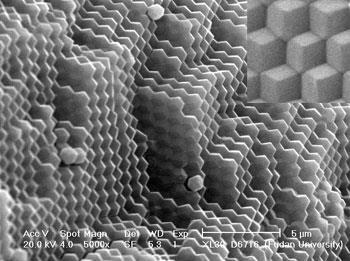Cheap two-step method to make angular crystals from tiny polymer beads
Chinese scientists have found an easy way to make highly regular crystal structures from a polymer mixture. The new technique could allow photonic materials for use in lasers or the ’invisibility cloaks’ of the future to be made more cheaply.
The researchers from Fudan University, China, used a two-step polymerisation process far simpler than the lithographic techniques used to make photonic crystals today. They added polymer beads around 1?m across to a solution containing a dissolved triblock copolymer that helped the beads pack together into a face centred cubic arrangement. When the team heated the packed microspheres to 90?C, they set to form rhombic dodecahedral particles in a densely packed lattice regular enough to have photonic properties.

Photonic materials precisely change the flow of light moving through them because they are made up of alternating regions of high and low dielectric constant. An example seen in nature is opal, whose play of colour is due to its nanostructure, not absorption bands as in most gems.
Dongyuan Zhao, professor at the Laboratory of Advanced Materials at Fudan University and author of the paper, told Chemistry World the polyhedral particles were a lucky find. ’Originally, we planned to synthesise hierarchically ordered macro-/meso- porous carbon by using polymer microspheres and triblock copolymer as templates,’ he said. ’To our surprise, we found that the ordered macrostructure is made of regular polyhedral particles instead of spherical ones.’
John Pendry, professor of physics at Imperial College London, told Chemistry World he welcomed the new way to make photonic materials. ’Photonics remains an exciting field with many challenges for manufacturing photonic materials - this technology looks like a very valuable simplification of the manufacturing process,’ he said.
Jonathan Edwards






No comments yet